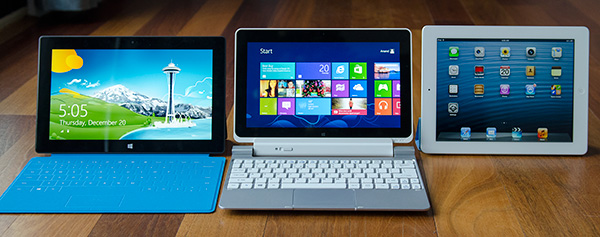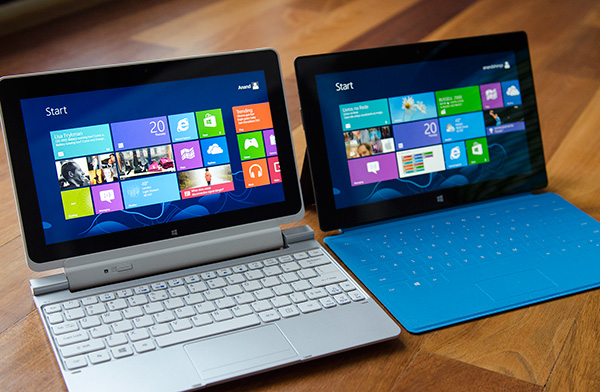The Clover Trail (Atom Z2760) Review: Acer's W510 Tested
by Anand Lal Shimpi on December 20, 2012 10:34 AM ESTFinal Words
This is a tricky conclusion to write, because as always there’s a lot of concluding that has to be done. On the one hand, we have Intel’s Clover Trail platform. On the other we have Acer’s Iconia W510 tablet itself. And on a magical third hand we have to conclude on behalf of Microsoft’s Windows 8.
I’ll start with the Intel hand.
Clover Trail is good. I only have NVIDIA’s Tegra 3 to compare it to at this point, and there Intel wins hands down. Performance is clearly better, tasks complete quicker, the modern UI is even more responsive. Power efficiency, once again, seems like a non-issue. The W510 in particular uses a smaller battery than most, but its battery life per watt-hour is very similar to Surface RT. Samsung’s ATIV Smart PC actually seems to be a better showcase of what Clover Trail can do from a power efficiency standpoint. If we haven’t squashed the notion of Intel being unable to build low power SoCs by now, Clover Trail should help drive the nail into that coffin. The debate is no longer about whether or not Intel can build something competitive with ARM on the power front, but whether Intel can execute quickly enough to defend its marketshare.
Backwards compatibility is a hit or miss advantage for Clover Trail. If you use it for the flexibility of being able to run nearly every Windows application available, then you’ll be pleased. Small apps that I’ve relied on for years just run without issue on Clover Trail. I don’t need to find modern replacements, my library of tools just work. I suspect this advantage will appeal in enterprise markets where custom applications are often on very long development cycles.
However if you’re expecting to be able to enjoy a similar experience to what you currently have on your Ultrabook, you’ll be sorely disappointed. Atom isn’t Core, the performance delta is dramatic. The Windows 8 desktop experience on Clover Trail is like using a notebook from several years ago. Performance is at least consistent thanks to the lack of any mechanical storage, but running intense workloads on the platform is hardly quick. Being quicker than most of the ARM platforms on the market today isn’t enough, Intel has to deliver a good experience across all applications. The experience is further hampered by sub-par UI performance in desktop mode. It actually feels like Tegra 3/Surface RT are faster when it comes to desktop UI performance. This highlights a disturbing trend within Intel’s ultra mobile products. The company continues to under-spec its ultra mobile GPUs. If Intel is really serious about both the tablet and smartphone markets it needs to build the best SoCs in the world, and that means delivering the best CPU and GPU performance.
I was impressed by the unique combination of closed box tablet OS and flexible/customizable desktop OS that Windows RT delivered. Windows 8 on Clover Trail takes that feeling to a completely new level. Being able to install and run nearly any weird, old application in one breath and then switch over to a fairly well optimized tablet experience in the next is pretty awesome. Where the experience falls short is really the performance of desktop mode and most of the applications I’d like to run unfortunately. Scrolling isn’t smooth, response time is pretty bad if you’re running anything demanding. You have to keep in mind that, at best, we’re talking about mainstream notebook CPU performance from around 2005. Until Intel revs Atom (which should happen next year, thankfully enough), the backwards compatibility story won’t be as awesome as it could be.
On the Acer side of things, the dock experience (particularly the troubles I had with the clickpad) also contributes to the W510 not being the perfect tablet+notebook in one. As a standalone tablet I prefer the W510, it’s got a great form factor and I love its light weight. As a docked system however, Samsung’s ATIV Smart PC seems to be the better choice.
The W510 itself is well executed, but overall the experience seemed a bit less polished than with Microsoft’s Surface RT. This is where things get really complicated. I want the SoC from the W510 but in the overall device experience that Microsoft’s Surface delivered. I even think Acer might have a form factor advantage in the W510 since it’s just so light. It’s a shame that the only x86 Surface device will be the bigger Pro model.
Ultimately my conclusion about the W510 in particular is a lot like what I felt about Surface RT. You know it’s going to be made obsolete in less than a year’s time, so you have to be ok with that fact if you’re going to pull the trigger today. Even then, the experience isn’t perfect. Microsoft still needs some updating on the Windows side to address bugs and quirks with the OS. Performance isn’t as big of a problem on the W510 as it was on Surface RT, but I’d still like to see more on that front as well.
Much of the same goes for Windows 8. Although its execution hasn’t been perfect, I really do like the OS and I see a lot of potential in these converged notebook/tablet devices. Especially for users who travel a lot, being able to have the best of both worlds in an extremely portable device is a wonderful dream. I think Microsoft has the right vision, but what we need to see are more revs to the OS to fully realize it. The real question is whether or not Microsoft will be able to deliver significant updates to Windows 8 as quickly as the market needs it.













104 Comments
View All Comments
strangis - Thursday, December 20, 2012 - link
"Which means nothing, as these mobile chips are too underpowered to actually run the desktop x86 applications"My ATIV 500 painting an 11x17 300dpi multilayer image in Sketchbook Pro with the active digitizer smoothly disagrees with your assumption.
Just saying.
Wolfpup - Thursday, January 3, 2013 - link
Of COURSE they run desktop programs. They run Firefox, OpenOffice (and older versions of MS Office you might already own), media tools, IM clients, all SORTS of things that aren't available or even possible on other platforms.No, it won't reasonably run Skyrim, but there's a ton that it will run.
Personally I think this is pretty awesome...you get a good for the form factor CPU that oh yeah, happens to actually be compatible with what you have, and the price is the same as ARM stuff.
What's bad is the GPU...seems like they have almost a 2009 smartphone GPU in there rather than something more appropriate for 2013...and then there's the issue that metro is locked down, not a real PC...but then that's why you want an x86 tablet to begin with...at least you get the real desktop and in that mode it's a real PC.
jeffkro - Thursday, December 20, 2012 - link
Basically for tablets and phones I prefer the android "library" so intel/windows really isn't for me anyways.SM123456 - Wednesday, February 13, 2013 - link
Yes, but Microsoft has to use a x86 CPU if they are to be able run Windows apps.Basically this device and all other Windows 8 tablets under $600 are grossly overpriced netbooks with touch added and a keyboard taken away.
The $199 Acer C7 Chromebook with its 1.1 GHz dual core Celeron processor is at least twice as fast as this thing.
Dribble - Thursday, December 20, 2012 - link
So we have windows RT that is optimised both around the ARM cpu's and tablets. There is no old software - everything that you can get for it should both run fine on tegra 3 and work well with a small touch screen. This means stuff should just work well - this is what apple do so well, and MS are trying to emulate.On the other hand there is full windows. Now the reason to get this not RT is backwards compatibility. Most *old* windows apps require higher performance cpu's (e.g core i3) a big screen, a mouse and a keyboard. They don't use touch at all.
Taking that into account an atom tablet has a screen that's too small, a cpu that's too slow and a bad mouse/keyboard experience - sure you could plug both in but then it's not really a tablet any longer is it? Also all that backward compatibility support uses effectively a different ui - it's not a clean and polished single interface. Stuff won't just work well - the experience won't be as good.
Hence if you want full windows you'd be much better off with a laptop/ultra book - they are still touch screen so you get any touch benefits but they have much faster cpu's, better keyboard, etc.
Shadowmaster625 - Thursday, December 20, 2012 - link
Not sure where you got that idea from. 99% of windows applications dont hardly use any cpu at all. Check task manager sometime. You will notice that most processes only consume a few seconds of cpu time per hour of system idle time. It is extremely rare for a windows application to peg even one cpu core to 100%.freedom4556 - Thursday, December 20, 2012 - link
You that that's a percentage and it depends on what CPU you're looking at right? That's like saying, "Yeah, I never need more than 1% of my horsepower even doing 150mph uphill in a headwind." when you drive a Lamborghini. Try it again in a Honda and you'll not even be able to do it, nevermind 100% usage.Do you have an i7 or an Atom?
B3an - Thursday, December 20, 2012 - link
One thing that stood out to me in this article, is the bugs/reboots you encountered. You pretty much blamed them on Win 8, or made it sound that way. Which i thought was unprofessional, especially for you Anand. As theres a very good chance they're to do with a particular app, drivers on this device, or even it's hardware. Win 8 is a very solid stable OS, even more so than Win 7 on release.ltcommanderdata - Thursday, December 20, 2012 - link
True. But hasn't it always been the case that app and driver instability gets fairly or unfairly associated with Windows? At the same time, when things are working well, Microsoft is happy if you think of yourself as enjoying a "Windows" PC or tablet regardless of what particular software or hardware you are using in/on Windows. I guess we'll have to see how common problems are with other CloverTrail tablets. If they show up in CloverTrail tablets from other manufacturers, then even if the underlying OS is stable it still becomes Microsoft's problem if people are having trouble developing reliable apps/drivers/tablet using it.Anand Lal Shimpi - Thursday, December 20, 2012 - link
The issue is these were first party apps developed by MS, and I've seen some evidence of the same on other non-W510 platforms (I just don't remember this being the case with Surface RT but I've been using these x86 platforms longer than I did Surface).I'm curious to read Vivek's take on the ATIV Smart PC to see if it mirrors my experience.
Take care,
Anand